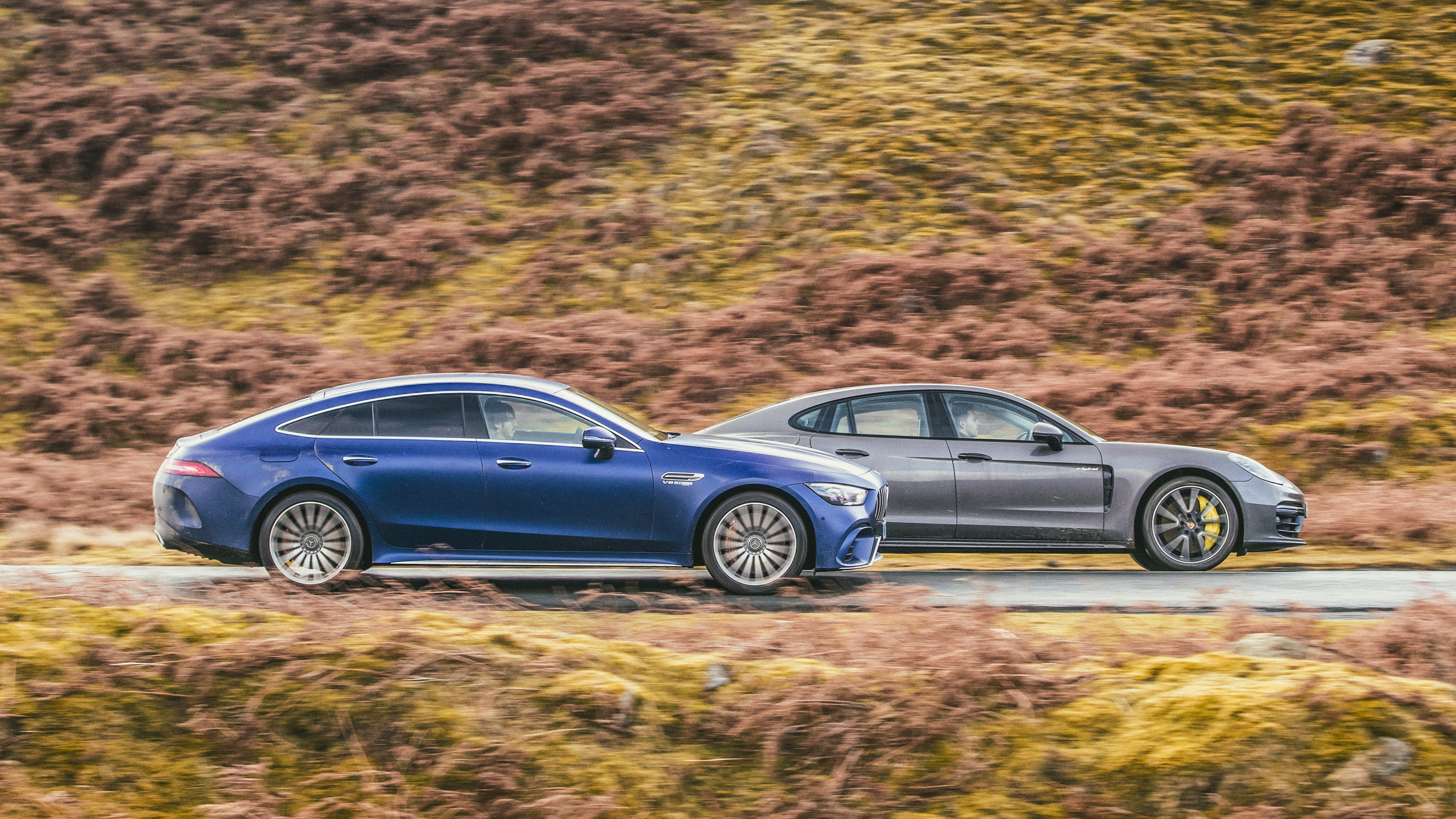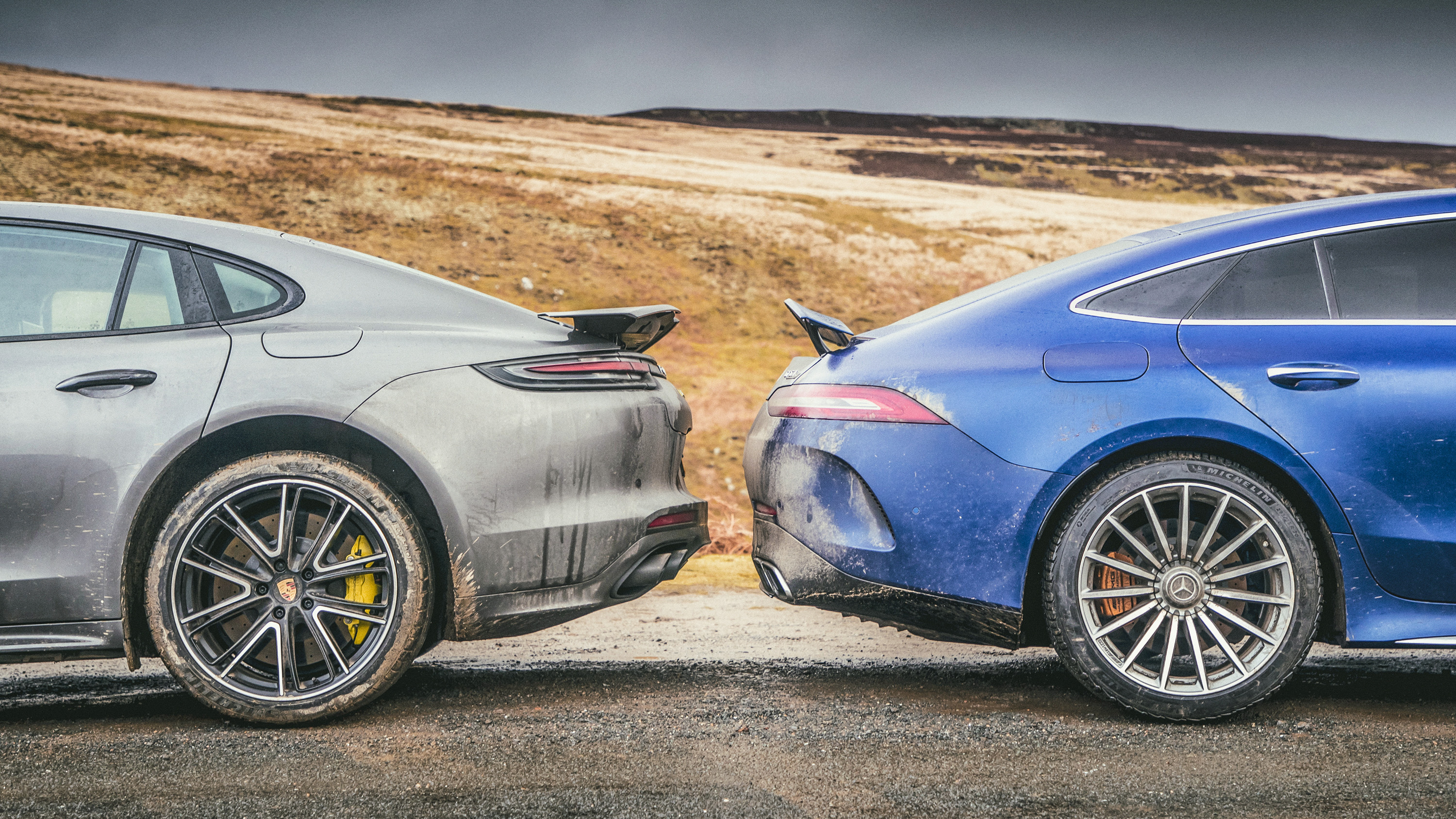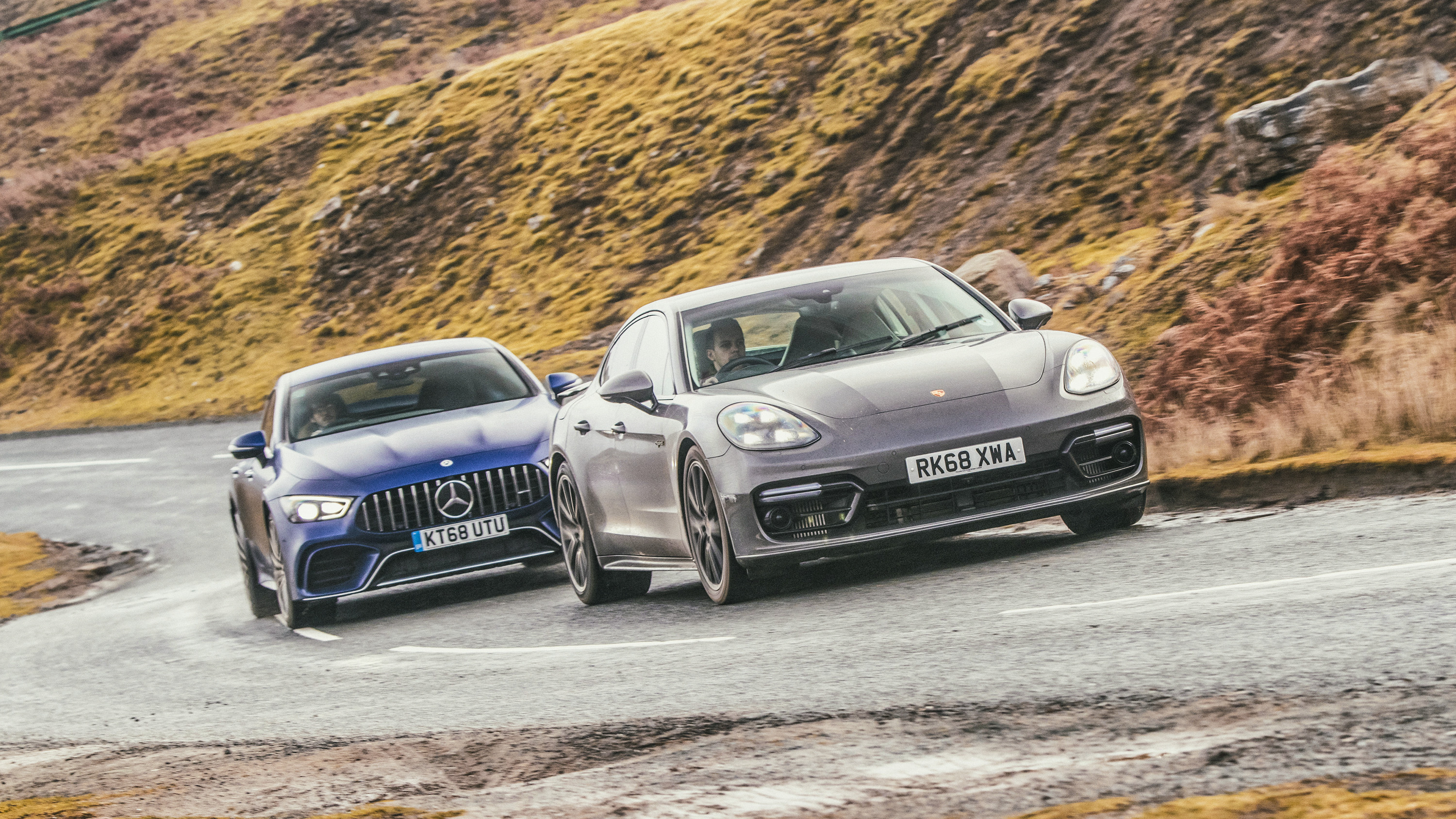
Mercedes-AMG GT 4-door vs Porsche Panamera Turbo S
The Panamera has inspired a laser-focused rival from Mercedes-AMG. Time for the face-off
We’re in the little market town of Barnard Castle, on the edge of the Pennine Hills, and the Mercedes AMG GT 4-Door is attracting so much attention, it’s almost as though some minor royal has decided to pay a surprise visit.
Nobody takes any notice of the Panamera. It’s a hulking presence, but its grey mass blends into the scenery so effectively it may as well be the world’s longest, most powerful and most expensive Volkswagen Passat.
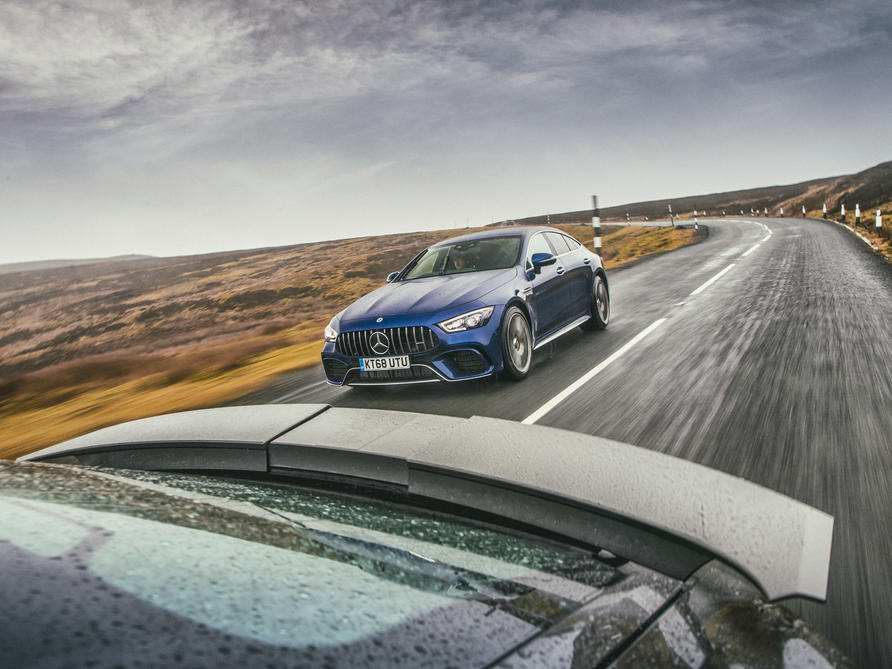
Words: Tom Harrison // Photography: Stuart Price
The Panamera is the reason the Mercedes exists, of course. Despite a wealth of options at the top of the Mercedes/AMG tree, customers were supposedly deserting the three-pointed star because they couldn’t upgrade to the car they really wanted to own - a four-door coupe bigger, more focused and more expensive than the CLS. A Mercedes Panamera.
It’s a nice enough problem to have - when customers desperately want to spend more money on your products - so we suspect Mercedes couldn’t have been happier to oblige. And so here we have a four-door AMG GT that, confusingly, isn’t really an AMG GT at all, because it’s based on the same MLA platform as the CLS, E-Class, GLE and so-on, and uses all-wheel drive.
Motive force comes from the same 4.0-litre twin-turbocharged V8 as other 63s, here with 631bhp and 664lb ft in big-boy ‘S’ specification (non-S is 577bhp). S adds dynamic engine mounts, an electronic locking rear diff, and the ability to disconnect the front driveshafts (for full-on Drift Mode) to the standard spec, which already includes adaptive air suspension, four-wheel steering and a nine-speed wet-clutch automatic gearbox.
Zero to 62mph takes 3.2 seconds and the top speed is 196mph, 0.2secs and 3mph faster than the non-S. This is adequate. And so it ought to be, for £135,550 - £14,000 more than a non-S GT, and around £40,000 more than a normal E63S.
But a very precise, very Germanic £3,223 less than the equivalent Porsche Panamera. The daddy of all Panameras, no less - the Turbo S e-Hybrid, or the PPTSEH, for short. Thank God it’s not a Sport Turismo. It too gets a 4.0-litre twin turbo V8, this time with 542bhp. A 134bhp electric motor, drawing power from a 14kwh lithium battery pack, gives a few miles of EV running and boosts total outputs to 671bhp and 627lb ft.

At a cost, mind, because the PPTSEH weighs a staggering 2,310kg. Heavy things, batteries and e-motors, seeing as the normal Panamera Turbo, effectively the same car sans electrification, is 315kg lighter. And substantially cheaper. And very nearly as fast. The Mercedes is 2,120kg. A featherweight, by comparison, but also over 100kg weightier than an E63S.
As much is obvious when you start driving. Nowadays you can, to an extent, engineer your way around excessive mass. But you can only take things so far before the laws of physics go “hang on a second, that’s not right” and unilaterally decide to pendulum you off into the nearest hedgerow. Just to prove a point.
Porsche has thrown a lot of acronyms at the Panamera to try and disguise its adiposity - PTV, PCCB, PASM, PTM, PDCC and PAA to name but six - and for the most part they do a grand job. But there’s no escaping this is a very big, very heavy car that would much rather be sat in the outside lane of an Autobahn than... wherever it is you are.
The amount of grip on offer is immense – but then it is wearing 325-section tyres on the rear-axle (like a Ford GT) and possessing of an all-wheel-drive system that doesn’t understand the meaning of the word ‘slide’. It doesn’t roll (because it’s got 48V stabilisation), direction changes are faithful and controllable and the steering is sensibly geared given the length, width and amount of grip generated by those fat tyres. It’s a very capable car, but at no point does it particularly excite, amuse or entertain its driver.
Top Gear
Newsletter
Thank you for subscribing to our newsletter. Look out for your regular round-up of news, reviews and offers in your inbox.
Get all the latest news, reviews and exclusives, direct to your inbox.
The Mercedes does, though. If these two occupy a kind of no-man’s land between luxury and sports saloons, the Porsche tends towards the former, while the Mercedes has more in common with the latter. On your average British B-road it feels significantly less wide (even though it’s actually a bit wider), so you can have more fun more often, and don’t wince when something comes the other way.
The steering is beautifully sharp, accurate and well-weighted, and because it acts on the rear-axle too (the Panamera is available with 4WS too, but this one didn’t have it), the GT 4-Door pivots into bends like a car half a tonne lighter and about three feet shorter. It feels more focused and purposeful than the Panamera - while there’s as much technology keeping you out of trouble, it seems more natural in its application. The whole experience is more fun, more energetic, more athletic. It might even be more fun than an E63. And that’s a big deal.
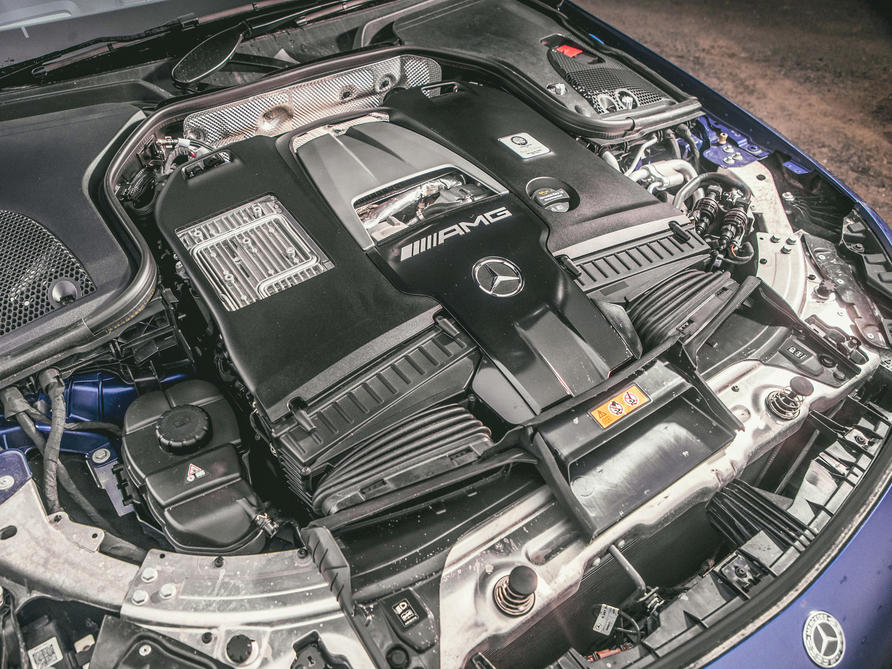
The same is largely true of the pair’s straight-line performance. The numbers say the Panamera is monstrously rapid - 0-62mph in 3.4 seconds and 192mph, only a fraction slower than the lighter, albeit less powerful Mercedes. But it simply doesn’t feel as swift as a car with over 670bhp ought to. There’s no doubt in my mind it’ll do those numbers (and then some, given Porsche is somewhat notorious for under-reporting performance figures), but the way it delivers them simply isn’t very exciting or engaging.
Unlike the Mercedes, which delivers its numbers in fairly dramatic fashion. There’s less of a delay when you prod the throttle, because there are fewer computers to wake up, and the ensuing surge of acceleration is accompanied by one of the world’s finest eight-cylinder soundtracks. The Porsche’s 4.0-litre V8 is seriously impressive, but the Merc’s is more charismatic, and damn close to Ferrari’s 3.9-litre V8 as far as responsiveness goes. Gearboxes, too - the Porsche’s eight-speeder is smooth when it needs to be and quick when it doesn’t, but it’s the Merc’s that reacts better to manual actuation.
Where the Porsche comes good is in the everyday. You can’t drive like a madman the whole time, and when you don’t, the delta between these two cars is far narrower. Both are tremendous cruisers - they ride well (the AMG is a massive improvement over the E63; that’s almost worth the extra £40k all by itself), have very comfortable seats front and back and in their meekest modes, they are easy as anything to drive. Stick the Merc in ‘Slippery’ cold-weather mode and it’s especially docile.
And of course the Panamera has the added benefit of being able to drive for a few miles at a time on electricity when conditions allow (as far as everyday driving goes, yes, it’s a benefit). Porsche claims 80.7mpg and 74g/km of CO2, but realistically mpg will be in the low 30s. Still, that represents a massive saving in fuel and tax over the 22.1mpg, 257g/km Mercedes (which admittedly will do its claimed numbers all day long). We’re led to believe there will be a hybrid version of that in time too, though.

The Panamera also benefits from the nicest interior of the two – in terms of quality, if not design. Though Mercedes has given the dashboard more rake and raised the centre console so you feel like you’re sitting in the car rather than on it, the GT still feels a bit too E-Class. It looks great, plusher and less business-like than the Porsche, but in parts the quality of the centre console (everything else is spot on) is closer to that of a £50k car than a £150k car.
Those ‘buttons’ on the centre console, meanwhile, really ought to be actual buttons rather than tiny displays, and nixing the infotainment’s rotary controller in favour of a touchpad is a step in the wrong direction. Say what you like about the Panamera’s gimmicky electric air vents, but it feels very well made inside, and the touchscreen infotainment is among the very best of its ilk.
Unlike the rest of the car. The Panamera’s very impressive technically, but this is not the one to go for. The added complication and weight of the hybrid system make for an ultimately less satisfying, less good car than a regular Panamera Turbo. But even so, while it’s not quite as high-quality an item as the Porsche (nor quite as aspirational a badge), the GT’s benefits more than outweigh its shortcomings. It’s a more engaging thing to drive thanks to its lighter weight, better steering and charismatic engine. As for looks - the entire population of Barnard Castle can’t be wrong.
Mercedes-AMG GT 4-Door GT 63 S (£135,550)
3982cc, twin-turbo V8, 631bhp, 664lb ft
0-62mph in 3.2secs, 196mph
22.1mpg, 257g/km
8/10
Porsche Panamera Turbo S e-Hybrid (£138,723)
3996cc, twin-turbo V8 plus electric motor, 671bhp, 627lb ft
0-62mph in 3.4 secs, 192mph
80.7mpg, 74g/km
6/10







